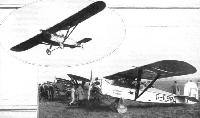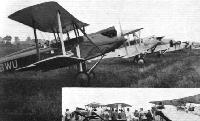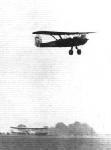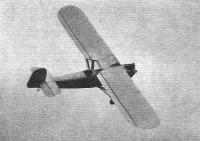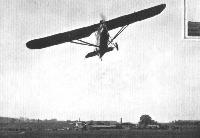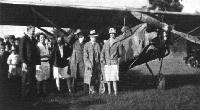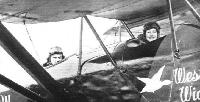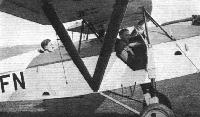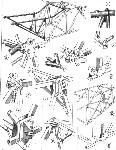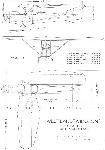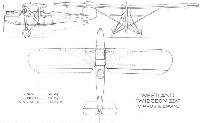
Westland Widgeon
Начиная с 1924 года, компания «Westland» с успехом продвигала на рынке двухместный легкий самолет Widgeon. Он был разработан и построен под обозначением Widgeon Mk I в целях участия в испытаниях легких двухместных самолетов, проводившихся британским Министерством авиации. Самолет конструктивно представлял собой подкосный высокоплан с тандемными открытыми кабинами, оснащенный первоначально звездообразным двигателем Blackburne Thrush мощностью 35 л. с. Впрочем, силовая установка оказалась слишком слабой, и самолет во время испытаний был поврежден. После чего получил обозначение Widgeon Mk II и был оснащен звездообразным двигателем Armstrong Siddeley Genet мощностью 60 л. с. После успешных испытаний самолет был поставлен в серийное производство под обозначением Widgeon Mk III.
Всего было построено 26 машин, в том числе несколько аппаратов под обозначением Widgeon Mk IIIA, на которых использовались металлический фюзеляж и новое шасси, а силовая установка включала различные поршневые двигатели по выбору их владельцев - от Armstrong Siddeley Genet II мощностью 75 л. с. до Cirrus Hermes II мощностью 120 л. с. С двигателем de Havilland Gipsy I мощностью 100 л. с. самолет Widgeon Mk III развивал максимальную скорость 174 км/ч.
Описание:
- Westland Widgeon
- Flight, September 1924
THE WESTLAND "WIDGEON" LIGHT MONOPLANE (No. 6) - Flight, July 1927
THE WESTLAND "WIDGEON III" - Flight, March 1929
THE WESTLAND "WIDGEON IIIA" - Flight, July 1929
BRITISH AIRCRAFT AT OLYMPIA
Фотографии
-
Aeroplane Monthly 1977-02 / N.Parnell - Wodonga's Widgeon
Регистрационный номер: VH-UHU [14], G-AUHU [14], G-AUKA [15], G-EBUB [14] -
Air Enthusiast 2003-07 / C.Justo - Widgeon on the wing
Регистрационный номер: G-AUGI [3] The oldest Westland-built aircraft flying, Widgeon III G-AUGI, returned in the air after a 62-year break in November 2002.
-
Air Enthusiast 2003-07 / C.Justo - Widgeon on the wing
Регистрационный номер: G-AUGI [3] Views of G-AUGI. Faithfully resored, is as original as possible.
-
Air Enthusiast 2003-07 / C.Justo - Widgeon on the wing
Регистрационный номер: G-EBJT [11] The Thrush-powered Widgeon I of 1926, it became G-EBJT.
-
Aeroplane Monthly 1986-02 / R.Riding - Westland Widgeon I /British pre-war ultralights/ (58)
Регистрационный номер: G-EBJT [11] The first Widgeon had an unusual planform and a Blackburne Thrush engine.
The short-lived prototype Widgeon was powered by a 35 h.p. three-cylinder Thrush engine. It crashed during the trials before its performance could be assessed. -
Aeroplane Monthly 1986-02 / R.Riding - Westland Widgeon I /British pre-war ultralights/ (58)
Регистрационный номер: G-EBJT [11] -
Aeroplane Monthly 1986-02 / R.Riding - Westland Widgeon I /British pre-war ultralights/ (58)
Регистрационный номер: G-EBJT [11] The Genet-engined Widgeon II competing in the Grosvenor Cup Race at Lympne in 1926.
-
Flight 1926-12 / Flight
Регистрационный номер: G-EBJT [11] "BANKING ACCOUNTS" AT LYMPNE: 3. The Westland "Widgeon" started scratch in the Grosvenor Race.
-
Aeroplane Monthly 1986-02 / R.Riding - Westland Widgeon I /British pre-war ultralights/ (58)
Регистрационный номер: G-EBJT [11] The Westland "Widgeon" with Armstrong-Siddeley "Genet" engine doing a vertical bank.
-
Flight 1926-12 / Flight
Регистрационный номер: G-EBJT [11] "PRATT'S" IN THE WORLD OF SPORT: The Westland "Widgeon," which made fastest time in the Grosvenor Cup Race at Lympne last summer, using "Pratt's."
-
Flight 1928-04 / Flight
Регистрационный номер: G-EBJT [11] AT THE LYMPNE EASTER MEETING: Dr. Whitehead-Reid coming in to land on his Westland "Widgeon II" with "Genet" engine.
-
Aeroplane Monthly 1986-02 / R.Riding - Westland Widgeon I /British pre-war ultralights/ (58)
Регистрационный номер: G-EBJT [11] LANDING IN THE DESPREZ CHALLENGE CUP COMPETITION: 1, Dr. Whitehead Reid in his Westland "Widgeon II" (Genet), "Wendy," at Filton on May 26, 1929. Dr. Whitehead Reid won second place.
Widgeon G-EBJT was the first prototype and as a Widgeon I was first registered in September 1926. It was damaged at that year's Lympne trials and was rebuilt as the Widgeon II with a 60 h.p. Genet I engine. The aircraft was sold to Dr Whitehead Reid in January 1928 -
Air Enthusiast 2003-07 / C.Justo - Widgeon on the wing
Регистрационный номер: G-EBJT [11] Widgeon I G-EBJT was rebuilt as the Mk.II prototype with a Genet.
-
Air-Britain Archive 1985-03
Регистрационный номер: G-EBJT [11], G-EBRO [6] THE BRISTOL AIR PAGEANT: A portion of the "Parade." Nearest the camera is a de Havilland "Cirrus-Moth." Ahead of that a Westland "Cirrus-Widgeon," an Avro "Cirrus-Avian" and a Blackburn "Genet-Bluebird."
A collection of flying school aircraft at a meeting, probably in April or May 1928. From left to right we have G-EBXG DH.60X Moth with Handley Page auto slots which was to be used by the Nottingham Flying Club; G-EBSN another DH.60X of the Bristol & Wessex Aero Club; G-EBRO a Westland Wigeon 3; G-EBVU an Avro Avian 3 purchased about this time by Capt Henry D.Wolff; an SE.5A G-EBIB; G-EBOO the Halton Aero Club Mayfly; and G-EBJT a Westland Widgeon 2.Другие самолёты на фотографии: Avro Avian / Type 594/616 - Великобритания - 1926De Havilland Gipsy Moth / Moth X - Великобритания - 1928De Havilland Moth / D.H.60 - Великобритания - 1925Halton H.A.C.1 Mayfly/H.A.C.2 Minus - Великобритания - 1927RAF S.E.5 - Великобритания - 1916
-
Flight 1929-05 / Flight
HOSTS, PERFORMERS, AND VISITORS: 2, "Wendy," her portrait, painted on the side of Dr. Whitehead Reid's Westland "Widgeon II."
-
Flight 1927-09 / Flight
EXPERIMENTAL LIGHT 'PLANE CLUB AT NOTTINGHAM: The work of this interesting club, full particulars of which were given in "Flight" for February 17 this year, is proceeding on very ambitious lines No 1 picture shows the partly-constructed tailless machine in the foreground, which is being erected entirely to the members' designs. Incidentally, these have been approved by an experienced designer wth the exception of a few minor details. On the right of No. 1, against the wall, is somebody's Westland "Widgeon"and on the left is the Club's own-built Linnet, in which they have been experimenting with an A.B.C. engine, but not with very good results.
-
Flight 1927-04 / Flight
Регистрационный номер: G-EBPW [4] The New Westland "Widgeon III," fitted with a "Cirrus" Mark II engine. This machine proved one of the fastest, if not actually the fastest, of its class at Bournemouth.
-
Aeroplane Monthly 1982-11 / P.Capon - Capon's Corner
Регистрационный номер: G-EBPW [4] The ill-fated Westland Widgeon G-EBPW during its visit to the Hampshire Air Pageant at Hamble on May 15, 1927. On June 6 this aircraft collided with a Blackburn Bluebird at the Bournemouth air races killing both pilots. The pilot of the Bluebird, W. H. Longton, gave P. T. Capon his first flight.
-
Flight 1927-05 / Flight
Регистрационный номер: G-EBPW [4] THE MIDLAND CLUB "AT HOME": Two views taken on the occasion of a successful aerial "At Home," held last Sunday, at Castle Bromwich, showing some of the machines lined up for a handicap race for three cups presented by the Club Council.
Другие самолёты на фотографии: De Havilland Moth / D.H.60 - Великобритания - 1925
-
Flight 1927-04 / Flight
Регистрационный номер: G-EBPW [4] GOOD HAND: Squadron Leader Tom England on the Westland "Widgeon III."
-
Flight 1927-11 / Flight
Регистрационный номер: G-EBRL [7] SUFFOLK CLUB'S AIR DAY: (4) The two Westland "Widgeons" which put in some excellent work at joy-riding.
-
Flight 1927-07 / Flight
Регистрационный номер: G-EBRL [7] THE WESTLAND "WIDGEON III": Three-quarter rear view.
-
Aeroplane Monthly 1988-07 / Personal album. Civil
Регистрационный номер: G-EBRL [7] Westland’s managing director, Robert Bruce, first owned this Westland Widgeon, registered in July 1927. It was raced into second place in that year’s King's Cup race, averaging 103 m.p.h. for the course. The Widgeon was destroyed in a crash at Yeovil on June 3, 1931. A lorryload of Pratts stands by.
-
Flight 1927-07 / Flight
Регистрационный номер: G-EBRL [7] Выпуск Widgeon осуществлялся в 1927-1928 годы. Компания «Westland» завершила его выпуск для того, чтобы сосредоточиться на выпуске самолетов Wapiti. Этот G-EBRL представлял собой вариант Widgeon Mk III.
TWO VIEWS OF THE WESTLAND "WIDGEON III" IN FLIGHT: Piloted by Mr. R. Brooke-Tapp. The upper picture gives a good idea of the excellent view from the pilot's cockpit. -
Flight 1929-10 / Flight
Регистрационный номер: G-EBRL [7] A well-tried favourite in a new guise - The Westland Widgeon Seaplane.
-
Aeroplane Monthly 1988-07 / Personal album. Civil
Регистрационный номер: G-EBRM [4] Westland Widgeon G-EBRM was owned and flown extensively by R. G. Cazalet and based at Wexford. Some time after this picture was taken ’RM was converted to Mk IIIA standard and given a metal fuselage and divided-type undercarriage. The original Cirrus III engine was replaced by a 105 h.p. Hermes I. Note the car-type cockpit door.
-
Flight 1928-04 / Flight
Регистрационный номер: G-EBRN [4] A "close-up" of the nose of Wing-Commander Manning's Westland "Widgeon III" revealing that well-tried combination the A.D.C. "Cirrus Mk.II" engine and the Fairey metal airscrew.
-
Air-Britain Archive 1980-01
Регистрационный номер: G-EBRN [4] Westland Widgeon G-EBRN see before setting off on Wing Commander Manning's unsuccessful Australia flight in 1928
-
Flight 1928-04 / Flight
Регистрационный номер: G-EBRN [4] FLYING TO AUSTRALIA: This is the Westland "Widgeon III" fitted with the A.D.C. "Cirrus Mk. II" 30/80 h.p. engine which is being flown to Australia from England by its owner, Wing-Commander E. R. Manning. He reached Marseilles from Lympne with one stop at Lyons on the first day, April 23.
-
Air Enthusiast 2003-07 / C.Justo - Widgeon on the wing
Регистрационный номер: G-EBRN [4] G-EBRN, a Mk.III was a UK post-war survivor. It was flown pre-war by Allen Wheeler and was revived in 1948, flying until 1951.
-
Aeroplane Monthly 1991-11 / Personal album. Civil
Регистрационный номер: G-EBRO [6] Westland Widgeon III G-EBRO was chosen by E. J. Riding as the subject of a model for a wartime issue of Aero Modeller (two separate words in those days). When he photographed the real thing at Walsall Municipal Aerodrome on March 8, 1936, it was owned by the South Staffordshire Aero Club and painted in the club colours of red and silver. Sadly, this wonderful aircraft was scrapped during the war.
-
Flight 1927-11 / Flight
Регистрационный номер: G-EBRO [6] THE WESTLAND "WIDGEON": Squad.-Ldr. The Hon. R. A. Cochrane and Flight-Lieut. Drew made their interesting anв successful European air tour on the Westland "Widgeon" (Cirrus II engine). The monoplane proved very stable in bumpy weather and a pleasure to fly. Neither the machine nor engine gave the least trouble during the long trip, thereby fully living up to their deserved reputations.
-
Flight 1940-09 / Flight
Регистрационный номер: G-EBRO [6] After the Lympne trials, the Westland Widgeon III was introduced as a private-owner type. It had Gipsy and Cirrus-Hermes engines.
-
Flight 1928-05 / Flight
Регистрационный номер: G-EBRO [6] THE BRISTOL AIR PAGEANT: A general view of the car park and some of the aeroplanes.
-
Flight 1931-07 / Flight
Регистрационный номер: G-EBRQ [8] "FORTY MINUTES": Some of the Competitors - Nos. 21 (Widgeon III Genet II), 20 (D.H.Moth Gipsy I), 18 (Widgeon III Gipsy I) and 14 (Spartan Hermes II) - refuelling at Heston on the first lap.
Другие самолёты на фотографии: De Havilland Gipsy Moth / Moth X - Великобритания - 1928Simmonds Spartan - Великобритания - 1928
-
Flight 1928-05 / Flight
Регистрационный номер: G-EBRQ [8] WAKEFIELD HANDICAP: The machines being wheeled between the posts at the end of the Utility Race.
-
Flight 1929-07 / Flight
Регистрационный номер: G-EBRQ [8] HULLO, TWINS!: F./O. G. Thorne on the Avro "Avian I" ("Cirrus II") and "J. Wellworth" on the Westland "Widgeon III" ("Genet"), who started together, flew the course together, and finished together!
Другие самолёты на фотографии: Avro Avian / Type 594/616 - Великобритания - 1926
-
Flight 1929-07 / Flight
Регистрационный номер: G-EBRQ [8] AIRCRAFT IN THE KING'S CUP: Westland "Widgeon III" (85-h.p. Siddeley "Genet").
-
Flight 1927-10 / Flight
Регистрационный номер: G-EBRQ [8] THE BRISTOL MEETING: The top picture shows Capt. Paget, the new test pilot to the Westland Company, performing on a Westland "Widgeon," and below are three of the four "Widgeons" which arrived in formation.
-
Air Enthusiast 2003-07 / C.Justo - Widgeon on the wing
Регистрационный номер: G-AADE [3] Mk.III G-AADE, powered by a DH Gipsy I. It was built in 1929 and was destroyed in a crash in September 1932.
-
Air Enthusiast 2003-07 / C.Justo - Widgeon on the wing
Регистрационный номер: G-AUGI [3] Period shot of G-AUGI during the first phase of its Australian flying career.
-
Aeroplane Monthly 1985-08 / Grapevine
Регистрационный номер: G-AUKA [15], VH-UHU [14], G-AUHU [14], G-EBUB [14] Westland Widgeon III VH-UHU “G-AUKA" at Boort, Victoria, Australia in May 1985.
-
Aeroplane Monthly 1989-11 / B.Weller - Vintage trio
Регистрационный номер: G-AUKA [15], VH-UHU [14], G-AUHU [14], G-EBUB [14] Widgeon IIIs had plywood-covered fuselages and constant-chord wings. They were fitted with 90 h.p. ADC Cirrus engines and had a maximum speed of 100 m.p.h. VH-UHU (G-AUKA) bears the type’s duck motif and the name Kookaburra.
-
Aeroplane Monthly 1989-11 / B.Weller - Vintage trio
Регистрационный номер: G-AUKA [15], VH-UHU [14], G-AUHU [14], G-EBUB [14] Widgeon IIIs had plywood-covered fuselages and constant-chord wings. They were fitted with 90 h.p. ADC Cirrus engines and had a maximum speed of 100 m.p.h. VH-UHU (G-AUKA) bears the type’s duck motif and the name Kookaburra.
-
Aeroplane Monthly 1989-11 / B.Weller - Vintage trio
Регистрационный номер: G-AUKA [15], VH-UHU [14], G-AUHU [14], G-EBUB [14] Len and Arthur Whittaker aloft in their beloved Widgeon in the Boort area.
-
Aeroplane Monthly 1989-11 / B.Weller - Vintage trio
Регистрационный номер: G-AUKA [15], VH-UHU [14], G-AUHU [14], G-EBUB [14] Len Whittaker (front) and Arthur Whittaker airborne near Boort in their Widgeon.
-
Aeroplane Monthly 1989-11 / B.Weller - Vintage trio
Регистрационный номер: G-AUKA [15], VH-UHU [14], G-AUHU [14], G-EBUB [14] Westland Widgeon VH-UHU, painted to represent G-AUKA, flying in the vicinity of Boort in Northern Victoria, Australia.
-
Aeroplane Monthly 1989-11 / B.Weller - Vintage trio
Регистрационный номер: G-AUKA [15], VH-UHU [14], G-AUHU [14], G-EBUB [14] The Whittaker brothers do not believe in changing their car either! They are seen here with their gleaming 1929 six-cylinder Chevrolet Tourer.
-
Aeroplane Monthly 1989-11 / B.Weller - Vintage trio
Регистрационный номер: G-AUKA [15], VH-UHU [14], G-AUHU [14], G-EBUB [14] The three veterans, Len and Arthur Whittaker pose proudly in front of the youngest of the trio - their 1928 Widgeon.
-
Aeroplane Monthly 1991-06 / T.Gwynn-Jones - Flying for gold (1)
Регистрационный номер: VH-UCI Airgold Ltd pilots correctly accused their Australian management of purchasing “rubbish ” when totally unsuitable aircraft such as this Westland Widgeon were delivered to New Guinea.
-
Aeroplane Monthly 1977-02 / N.Parnell - Wodonga's Widgeon
Регистрационный номер: VH-UHU [14], G-AUHU [14], G-AUKA [15], G-EBUB [14] -
Aeroplane Monthly 1977-02 / N.Parnell - Wodonga's Widgeon
Регистрационный номер: VH-UHU [14], G-AUHU [14], G-AUKA [15], G-EBUB [14] -
Air Enthusiast 2003-07 / C.Justo - Widgeon on the wing
Регистрационный номер: VH-UHU [14], G-AUHU [14], G-AUKA [15], G-EBUB [14] Widgeon III G-EBUB was exported to Australia in August 1928, becoming G-AUHU. It later became VH-UHU and was airworthy into the 1970s.
-
Flight 1927-07 / Flight
THE WESTLAND "WIDGEON III": Front view. The engine is a "Cirrus," Mark II.
-
Flight 1931-07 / Flight
SCENES AT THE START: 1 - Nos. 23 (Avian IV Cirrus III), 22 (Avian IV Cirrus III), 21 (Widgeon III Genet II), 28 (Martlet Genet II), 27 (Widgeon III Hermes II) lined up for the start.
Другие самолёты на фотографии: Avro Avian / Type 594/616 - Великобритания - 1926Southern Martlet - Великобритания - 1929
-
Flight 1927-10 / Flight
Регистрационный номер: G-EBRL [7] BRISTOL CLUB'S AIR DAY: These are two general views of the machines which took part at the meeting at Filton, giving an idea of how representative the machines were of the light aeroplane class.
Другие самолёты на фотографии: Blackburn Bluebird / L.1 - Великобритания - 1924De Havilland Moth / D.H.60 - Великобритания - 1925
-
Flight 1932-05 / Flight
The start of the first heat for the Race at Skegness: (Left to right) "Avian," "Cadet," "Avian," "Spartan," "Widgeon" and Autogiro - the last, in its first race.
Другие самолёты на фотографии: Avro Avian / Type 594/616 - Великобритания - 1926Avro Cadet / Type 631/643 - Великобритания - 1932Cierva/Avro C.19 - Великобритания - 1929Simmonds Spartan - Великобритания - 1928
-
Flight 1928-04 / Flight
EASTER AT HADLEIGH: Here are seen the light aeroplanes parading past the crowd on Monday afternoon. Two Westland "Widgeons'' are leading and the Blackburn "Bluebird" is following up. The public was able to make a thorough study of all the light aeroplane types at present on the market, for each type was represented in numbers.
Другие самолёты на фотографии: Blackburn Bluebird / L.1 - Великобритания - 1924
-
Flight 1927-08 / Flight
SOME STARTERS IN THE KING'S CUP RACE: D. A. N. Watt gets away on his "Avian." In the background, the Blackburn "Bluebird" and the Westland "Widgeon III" waiting to start.
Другие самолёты на фотографии: Avro Avian / Type 594/616 - Великобритания - 1926Blackburn Bluebird / L.1 - Великобритания - 1924
-
Flight 1929-05 / Flight
Mr. H. Penrose, of the Westland Aircraft Co. Ltd., demonstrating the Westland "Widgeon" monoplane above a thick row of spectators and cars at the Northampton meeting.
-
Flight 1927-05 / Flight
THE HAMPSHIRE AIR PAGEANT: Major L. P. Openshaw well away on the Westland "Widgeon III."
-
Flight 1927-08 / Flight
SECOND.MAN HOME IN THE KING'S CUP RACE: Capt. McDonough finishing on the Westland "Widgeon III" with "Cirrus II" engine, and, on the right, being led in by Sqdn.-Leader England and Colonel Darby.
-
Flight 1928-07 / Flight
THE KING'S CUP AND SIDDELEY TROPHY: Some competitors starting from Hendon on the first stage. R. G. Cazalet on a Widgeon III ("Cirrus II"), and just behind him Flight-Lieut. Ragg on an Avian ("Cirrus").
Другие самолёты на фотографии: Avro Avian / Type 594/616 - Великобритания - 1926
-
Flight 1927-08 / Flight
THE NOTTINGHAM FLYING MEETING: Harold Brooklyn, on the Westland "Widgeon III" ("Genet") who finished third in the Grosvenor Cup race.
-
Aeroplane Monthly 1981-09 / A.Wheeler - The Bournemouth Easter Meeting
GOOD FRIDAY AT BOURNEMOUTH: 4, In the Branksome "Cirrus" Handicap Stakes. In the foreground England on the "Widgeon III" low over the crowd.
-
Aeroplane Monthly 1981-09 / A.Wheeler - The Bournemouth Easter Meeting
GOOD HANDICAPPING: Four machines approaching the finishing line in the first heat of the Holiday Final Handicap on Easter Monday. The machines are, in the order of finishing: OU (Sempill), QL (Cantrill), JT (Openshaw), and KQ (Hamersley).
Two Moths, a Widgeon and an Avro 504 approach the finishing line in another race.Другие самолёты на фотографии: Avro Avian / Type 594/616 - Великобритания - 1926Avro Avro 504N - Великобритания - 1920De Havilland Genet Moth - Великобритания - 1926
-
Flight 1927-06 / Flight
THE RACE FOR THE LADIES' PURSE: Mrs. Eliott-Lynn is seen wining the race on the Westland "Widgeon III" monoplane, with Miss O'Brien second on "Moth" MF.
Другие самолёты на фотографии: De Havilland Moth / D.H.60 - Великобритания - 1925
-
Flight 1927-09 / Flight
Регистрационный номер: G-EBRQ [8] "AND SO TO BED" :- These interesting pictures were kindly sent by Mr. "Harold Brooklyn," a private owner, who flies a Westland "Widgeon." In this he made an air tour this summer in England, carrying, as will be seen, a portable tent and equipment, as well as, apparently, an inflated rubber raft or boat.
-
Flight 1928-03 / Flight
Регистрационный номер: G-EBRQ [8] THE AIR CAMPERS: This idyllic picture shows one of Mr. "Harold Brooklyn's" camping spots during one of his air tours in this country. He does not reveal the identity of the spot, and perhaps he is wise, for his choice is so excellent that it might quickly be followed. The two figures are seated in the collapsible rubber boat which was used during the night as a bed. The tent is 7 ft. by 5 ft., and other equipment taken to last two people a fortnight included bedding, stove and cooking utensils. All the gear was carried in the Westland "Widgeon" beside Mr. "Brooklyn" and his passenger.
-
Flight 1929-01 / Flight
Регистрационный номер: G-EBRQ [8] This is Mr. "Harold Brooklyn's" Westland "Widgeon" monoplane somewhere in North Africa during the course of a present air tour. He is a private owner and often carries camping kit in his machine when touring.
-
Flight 1928-09 / Flight
In this picture are (left to right) Mr. B. J. Hanstock, of the Anglo-American Oil Co., Ltd., Mrs. St. J. Plevins, Mr. "Harold Brooklyn," D.S.O., and Lord and Lady Blyth. The occasion was the landing of Mr. "Brooklyn" in his Westland "Widgeon" in a field near the house of Mr. St. J. Plevins, of the Anglo-American Oil Co., Ltd., followed by luncheon with the latter.
-
Flight 1928-02 / Flight
The Port Elizabeth Club: On the left of Lady Heath is Major Miller, who is prominently associated with civil aviation in South Africa, and has helped in the formation of the clubs by flying his own D.H. "Moth," and raising funds. On the right is the Lord Mayor of Port Elizabeth, then comes Capt. Swann, the Club's instructor, and finally, Mr.Hurch, President of the Club. In the background is the nose of the Westland "Widgeon."
-
Flight 1928-04 / Flight
Регистрационный номер: G-EBRM [4] PERSONALITIES AT HADLEIGH: Mr. R. G. Cazalet and Flt.-Lt. Rose, who won the "On To Hadleigh" Rally in the former's Westland "Widgeon."
-
Flight 1927-04 / Flight
A Fair Passenger: Miss Rachel Bruce, youngest daughter of Mr. Bruce, of the Westland Company, flew continuously as passenger with Squadron Leader Tom England in the "Widgeon III." In a forced landing the machine turned over on its back, without sustaining serious damage, and without injury to the occupants, so that the parasol monoplane would appear to be fairly safe.
-
Flight 1928-02 / Flight
With the South African Clubs: Lady Heath performing the christening ceremony of the Port Elizabeth Club's machine, the Westland "Widgeon." It was christened "The Lady Heath." The Lord Mayor of the town is seen third from the left.
-
Flight 1927-12 / Flight
THE WESTLAND "WIDGEON" ABROAD: These three views were taken in Australia at the christening of the "Widgeon" which was shipped to Brockway Motors, Ltd., Australia, who have included the sale of light aeroplanes as a branch of their motor business. This particular machine was entered by them in the Queensland Aerial Derby Speed Championship Cup Race on November 12, and it won the prize.
-
Flight 1927-07 / Flight
Cockpits of the Westland "Widgeon III": Note the door giving access to the front cockpit. Also the luggage compartment in the deck fairing.
-
Flight 1929-03 / Flight
FLIGHT TESTING NEW LIGHT 'PLANE ENGINE: These two photographs show the Westland "Widgeon" monoplane fitted with the A.B.C. "Hornet" engine. Note the neat cowling, which is completed by a spinner not shown in the photographs.
-
Air Enthusiast 2003-07 / C.Justo - Widgeon on the wing
Регистрационный номер: G-EBRO [6] Mk.III G-EBRO sprouted a somewhat ungainly-looking covered cabin in 1928. It was scrapped during World War Two.
-
Flight 1929-10 / Flight
Регистрационный номер: G-EBRM [4] THE LATEST "HERMIAN": R. G. Cazalet's Westland "Widgeon," in which he has just installed a Cirrus "Hermes" engine.
-
Flight 1930-07 / Flight
Регистрационный номер: G-EBRM [4] HARD LINES! Mr. R. Cazalet, who has flown his Widgeon (Hermes) in many races at air meetings, has always had an almost insuperable handicap. At Bristol he finished third only to find that he had been disqualified for slightly cutting the Filton corner.
-
Flight 1929-07 / Flight
Регистрационный номер: G-AAFN [3] AIRCRAFT IN THE KING'S CUP: Westland "Widgeon III" (75-h.p. "Cirrus II").
-
Flight 1929-04 / Flight
Регистрационный номер: G-AAFN [3] AEROBATICS AT LYMPNE AIR MEETING: Mr. H. Penrose putting the Westland "Widgeon" (Cirrus) through its paces.
-
Flight 1929-05 / Flight
Регистрационный номер: G-AAFD Christening of the Westland "Widgeon" (Gipsy), belonging to the Anglo-American Oil Co., Ltd., at Croydon Aerodrome. Its name, appropriately enough, is "Miss Ethyl."
-
Aeroplane Monthly 1991-02 / Personal album. Civil
Регистрационный номер: G-AAGH [2] Seen at Doncaster in 1938 is aged Westland Widgeon IIIA G-AAGH, first registered in September 1930 and destined to remain with its parent company as a communications aircraft for 19yr. Fitted with a 105 h.p. Hermes I engine, this last survivor of the breed was destroyed and burnt after it crashed into a hangar at Merryfield, Somerset following a pilotless take-off.
-
Aeroplane Monthly 1981-01 / D.Middleton - Harald Penrose /Test Pilot Profile/ (2)
Регистрационный номер: G-AAGH [2] Penrose’s bursts of crazy flying in Widgeon G-AAGH will never be forgotten by those who watched his hilarious performances.
-
Flight 1929-03 / Flight Advertisements
The WESTLAND WIDGEON IIIA. With Cirrus III or Gipsy Engine. New Split Axle Undercarriage.
-
Flight 1929-07 / Flight
AIRCRAFT IN THE KING'S CUP: Westland "Widgeon III" (85-h.p. "Gipsy").
-
Flight 1929-04 / Flight
"STALLED BUT STABLE": A Westland "Widgeon," with "Gipsy" engine, in stalled flight above Cricklewood, piloted by Mr. E. A. Jones. This particular "Widgeon" is the property of the Anglo-American Oil Co., and is fitted with Handley Page automatic slots.
-
Flight 1929-07 / Flight
GETTING THEM DOWN AT WAALHAVEN: Various styles of landing over the tape are shown. 2. Cazalet on "Cirrus-Widgeon."
-
Flight 1929-11 / Flight
WESTLAND "HERMES-WIDGEON"
-
Flight 1929-07 / Flight
The Westland Stand nearly defied our photographer, as no viewpoint could be found which would show the limousine, the "Wapiti" and the "Widgeon."
Другие самолёты на фотографии: Westland Wapiti - Великобритания - 1927Westland Wessex / Westland IV - Великобритания - 1929
-
Air-Britain Archive 1986-01
Регистрационный номер: G-AADE [3] Portsmouth Municipal Aerodrome at home to an air display during 1932. Right of the apron with Fury G-ABSE is the PSIoW Avn Wessex G-ABVB (CofA 5.32) while the row below that includes Widgeon G-AADE (w/o 9.32). Also identifiable are Sports Avian G-AAWI, Moths G-AAIM, G-AAJJ, Arrow G-ABOB and Klemm L.27a G-ABOP; several rows of Furies lead to the nearest row with two Harts (?), Vickers Virginia, Imperial Airways Argosy G-AACI, Desoutter G-AAZI and Fokker F.VIIa G-EBTS all visible.
Другие самолёты на фотографии: Armstrong Whitworth Argosy - Великобритания - 1926Avro Avian / Type 594/616 - Великобритания - 1926De Havilland Gipsy Moth / Moth X - Великобритания - 1928Fokker F.VII / C-2 / F.XIV - Нидерланды - 1924Hawker Fury - Великобритания - 1931Hawker Hart - Великобритания - 1928Klemm L.25 - L.28 Swallow - Германия - 1927Koolhoven FK-41 - Нидерланды - 1928Spartan Arrow - Великобритания - 1930Vickers Virginia - Великобритания - 1922Westland Wessex / Westland IV - Великобритания - 1929
-
Flight 1929-06 / Flight
Регистрационный номер: G-AAFN [3] This photograph shows the exceptional easy access to the cockpits of the Westland "Widgeon" monoplane, and the freedom of view downwards, particularly from the passenger's cockpit. Incidentally, the new undercarriage is seen on this machine. Mr. H. Penrose is in the rear cockpit. He is one of the Westland Aircraft Co.'s pilots.
-
Flight 1930-07 / Flight
Mr. Napier's "Widgeon" (Gipsy I), No. 18, had passenger's cockpit covered in, a fairing, to the bottom of fuselage to cover controls, new fairing over compression legs, and neat engine cowling. (98.67 m.p.h.)
-
Aeroplane Monthly 1989-11 / B.Weller - Vintage trio
Регистрационный номер: G-AUKA [15], VH-UHU [14], G-AUHU [14], G-EBUB [14] Arthur Whittaker, possibly the world's oldest pilot, at the controls of the world's sole airworthy Westland Widgeon.
-
Aeroplane Monthly 1989-11 / B.Weller - Vintage trio
Регистрационный номер: G-AUKA [15], VH-UHU [14], G-AUHU [14], G-EBUB [14] The minimal panel of the Widgeon, with basic instrumentation.
-
Aeroplane Monthly 2000-12 / Skywriters /Readers' letters/
Регистрационный номер: G-AUKA [15] The recovered remains of Westland Widgeon Kookaburra at the Central Australian Aviation Museum at Alice Springs.
-
Flight 1924-09 / Flight
Wind-tunnel model of the Westland "Widgeon" parasol monoplane. No engine is shown, but will be fitted in the nose.
-
Aeroplane Monthly 1988-12 / P.Masefield - Wren
Wren's first contribution to C. G. Grey's The Aeroplane was published in the issue for June 22, 1933. It was titled: Identification made easy - a caricaturist’s memories of the prominent characteristics of some popular aeroplanes.
Другие самолёты на фотографии: Airspeed Ferry / AS.4 - Великобритания - 1932Armstrong Whitworth Atlas / Ajax - Великобритания - 1925Avro Avro 504 - Великобритания - 1913Blackburn Bluebird / L.1 - Великобритания - 1924Blackburn Iris / R.B.1 - Великобритания - 1926Bristol Bulldog - Великобритания - 1927Cierva/Avro C.30A / Rota - Великобритания - 1932Comper Swift / CLA.7 - Великобритания - 1930De Havilland Gipsy Moth / Moth X - Великобритания - 1928De Havilland Puss Moth / D.H.80 - Великобритания - 1929Fairey Fairey IIIF - Великобритания - 1926Handley Page H.P.42 / H.P.45 - Великобритания - 1930Handley Page Hyderabad/H.P.24 / Hinaidi/H.P.33 / Clive/H.P.35 - Великобритания - 1923Hawker Fury - Великобритания - 1931Klemm L.25 - L.28 Swallow - Германия - 1927Supermarine Southampton / Solent - Великобритания - 1925Vickers Jockey / Type 151 - Великобритания - 1930Vickers Virginia - Великобритания - 1922Westland Wapiti - Великобритания - 1927
-
Flight 1927-07 / Flight
THE WESTLAND "WIDGEON III": Some constructional details. 1, shows the manner of fairing the wing strut attachment with papier mache, the actual metal fitting being shown in 2. A typical fuselage joint is illustrated in 3, while 4 shows the attachment of lift struts to lower fuselage longeron. The hinge on the rear wing spar is shown in 5. This engages with a corresponding fitting on the centre-section, and forms the hinge for folding the wings.
-
Flight 1927-07 / Flight
THE WESTLAND "WIDGEON III": Details of the two types of engine mountings which have been standardised. 1, shows the welded steel tube mounting for a "Cirrus" engine, with a more detailed view of a front engine bracket in 2. The mounting for the "Genet" engine is shown in 3, with details of the Duralumin face-plate in 4. Sketches A, B, C and D refer to details at corresponding points of 3.
-
Flight 1929-02 / Flight
THE METAL VERSION OF THE WESTLAND "WIDGEON" LIGHT 'PLANE: This machine is now coming through the works at Yeovil, and the above sketches show some of the constructional features of the fuselage. The engine mounting (for an "in-line" engine) is a separate unit, and is of welded steel tube. The main fuselage is of square-section Duralumin tube. The lug at 4 is the attachment of the front struts of the float undercarriage. A new type of "split" land undercarriage is now fitted, and the telescopic leg is attached at 7. 9 is the wing-strut attachment, and the tension across bottom of fuselage is taken by tie rods. The general scheme of the rear portion of the fuselage is as shown in 10, and the method of attaching struts to longerons is as shown in 11.
-
Flight 1924-09 / Flight
Westland Widgeon 2-seater Light Monoplane
-
Flight 1927-07 / Flight
Westland "Widgeon III" "Cirrus II" or Armstrong Siddeley "Genet" Engine
-
Flight 1929-03 / Flight
Westland "Widgeon IIIA" Cirrus III Engine
-
Flight 1929-07 / Flight
Westland "Widgeon IIIA" Cirrus III Engine
Тип фотографий
- Все фото (112)
- Цветные фото (3)
- Ч/б фото (96)
- Кабина (2)
- Обломки (1)
- Модели, рисунки, схемы (10)







































